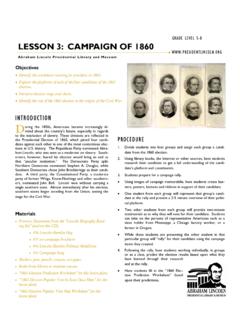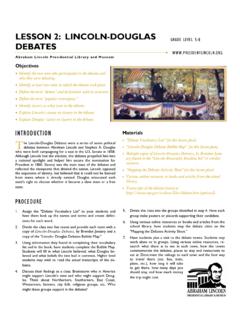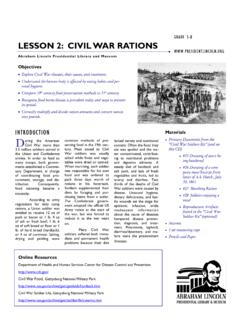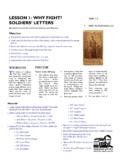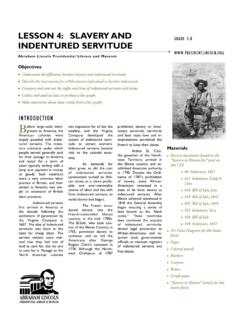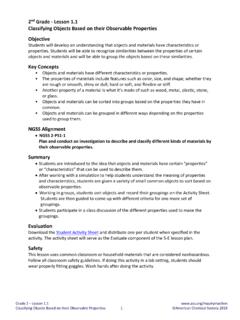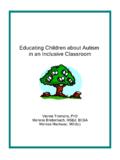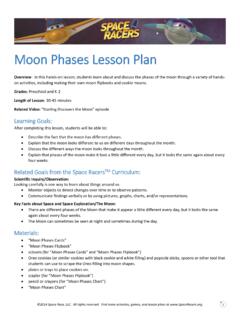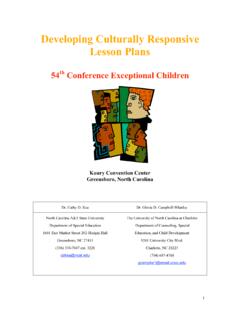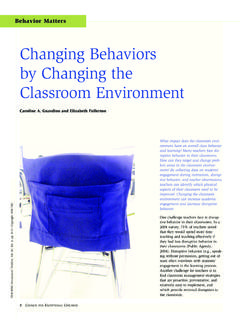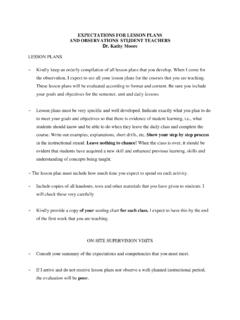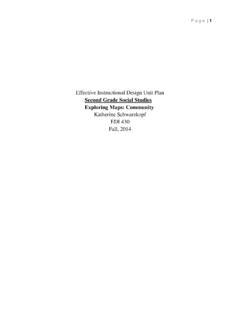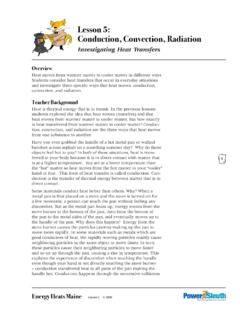Transcription of Lesson 5 Analyzing Political Cartoons - Lincoln Log Cabin ...
1 INTRODUCTION the classroom help to hone these critical thinking skills. Involving the student in the process of cartoon analysis can lead to further historical research in order to better under-stand the circumstances which led to the original drawing of each cartoon. casual or uninformed reader. To fully understand a car-toon, the reader must have an understanding of the basic techniques used by the car-toonists as well as a knowl-edge of history and current events. Armed with this background, the reader must apply critical thinking skills to decipher and interpret the cartoonist s meaning and point of view.
2 Activities which utilize Political Cartoons in M odern American po-litical Cartoons have been around since the nineteenth century. The increase in newspaper and magazine circulation in the 1800 s provided a rich envi-ronment for the rise and use of Political Cartoons . Thomas Nast, Volck and Joseph Keppler penned many popu-lar Cartoons advocating so-cial reform. The reason be-hind their popularity is ap-parent. People with minimal reading abilities could under-stand and relate to a format that communicated powerful ideas in a humorous, enlight-ened manner.
3 Through the use of analogy, irony, sym-bolism, and exaggeration the cartoonist expresses the themes and problems of their historical era. Political Cartoons express opinions about pub-lic issues and public individu-als. They appeal to all levels of readers. Often the full meaning of the cartoon is too subtle to grasp by the Materials Political Cartoons from Lincoln Biography Reading Kit (and on this CD or from additional resources listed below)
4 #51 A Phenomenon of Portraiture #52 Passage Through Baltimore #53 Flight of Abe #54 President s Uncomfortable Seat #55 President s Inaugural #56 Great & Astonishing Trick of Old Abe #57 Writing the Emancipation Proclamation Objectives Identify five elements of a Political cartoon (symbol, exaggeration, irony, labeling, and analogy). Identify the methods and techniques used by the cartoonist to convey a message. Draw on higher-level thinking skills to interpret the elements of a politi-cal cartoon and to understand the cartoonist s point of view.
5 Express their interpretation of the cartoon with their classmates and sup-port their conclusions with evidence gleaned from the cartoon. Create their own Political cartoon using the elements described above, as well as other artistic techniques that convey meaning. Reflect in writing on the power of images to convey meaning, ideas and points of view. Abraham Lincoln Presidential Library and Museum Lesson 5: Analyzing Political Cartoons GRADE LEVEL 5-8 #58 Unheeded Advice #59 Abraham the Last #60 The National Joker Computers and Internet Access (optional) Cartoon Analysis Worksheet (in this Lesson plan) Paper, Scrap Paper, Tracing Paper, etc.
6 Markers, Pens, Pencils, Chalk, Charcoal, etc. Political Cartoon Drawing Activity Sheet (in this Lesson plan) Notebooks or Journals PART I: EXPLORE THE ELEMENTS OF Political Cartoons 1. Ask students to draw symbols with which they are familiar and challenge their classmates to iden-tify their meaning (scales of justice, dove, McDon-ald s Golden Arches, Nike logo, Olympic rings are some examples). 2. Discuss how pictures can convey messages and meanings. Can images be more powerful than words?
7 Are words al-ways necessary? Can lines express emotion or movement? 3. Introduce students to the elements of Political car-toons. Show examples of each element to the class. The Cartoons you use can be current or tied to a specific topic you are covering in class. 4. Invite students to com-plete the on-line exercise at: PART II: ANALYSIS OF A Political CARTOON 1. Working in small groups, have students utilize the Cartoon Analysis Work-sheet to analyze a politi-cal cartoon.
8 Give a dif-ferent cartoon to each group. 2. Have a student from each group present their analysis to the class. They should be able to support their position with evidence taken di-rectly from the cartoon. The rest of the class should take notes on these presentations and be prepared to reflect upon the class discussion in their journals. PART III: CREATING A PO-LITICAL CARTOON 1. Assign a specific topic or ask students to write down their feelings or what they want to make a statement about.
9 2. Have students sketch out a rough idea of their car-toon on sketch or scrap paper using the above tips. 3. Using the Political Car-toon Drawing Activity Sheet have students create their own Political cartoon incorporating some of the five key ele-ments studied above. 4. Have students explain their drawing by answer-ing the questions on the back of the Activity Sheet. 5. Have students present their Cartoons for the class. Let the class ana-lyze the Cartoons using the Cartoon Analysis Worksheet.
10 6. Hang the Cartoons around the classroom for the class to examine and enjoy. PART IV: REFLECTION Use the questions below to prompt students to reflect in writing in their classroom journals. 1. Which cartoon examined in class do you think was most effective or persua-sive and why? 2. Is humor an effective tool when addressing sensi-tive, divisive or volatile subjects? 3. Describe the steps you took in creating your own Political cartoon. What process did you use to translate your intangible idea into a concrete drawing?
